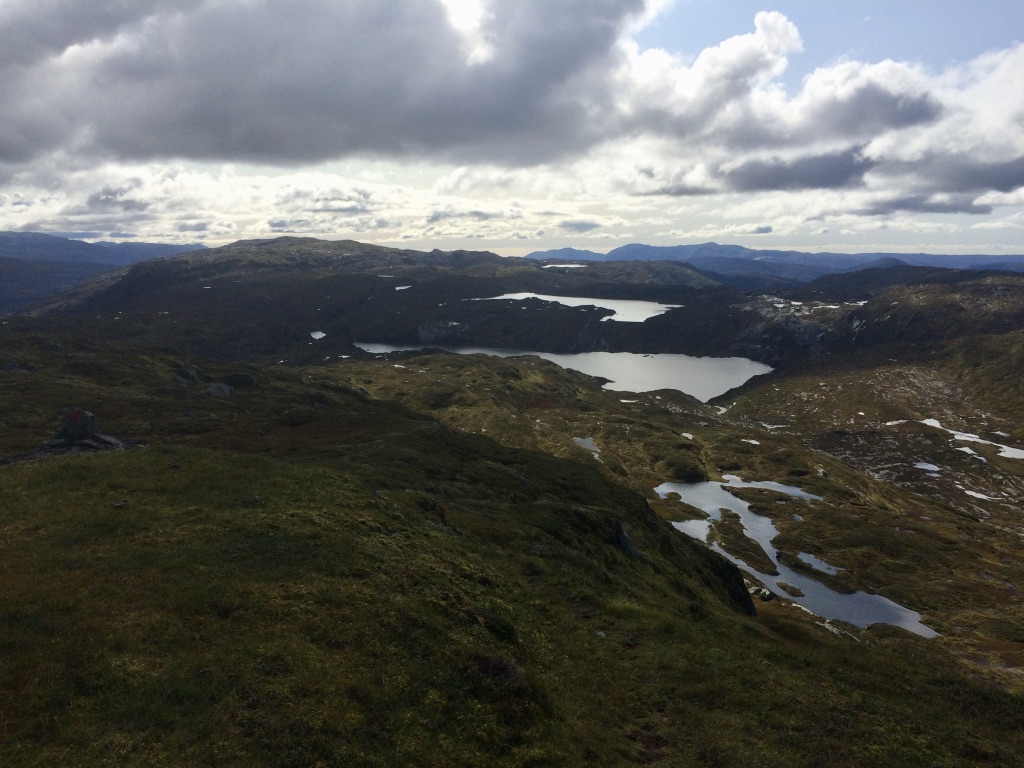7 Days Hiking Alone from Voss to Dale, Norway

When I was looking for a solo hiking/camping trip to do this year, I knew that I wanted it to be in Norway. I had never been, and I knew that it is a multi-day hiker’s dream. Deciding on a route was the first challenge: the Norwegian Trekking Association (aka DNT) is not playing around, and there are around 22,000km of maintained and marked trails which thread the length of the country.
After a week scouring UT.no (official trail site, also in English), I gave up and instead decided to copy a section of the route completed by another hiker as described on their excellent A Woman Afoot blog. Ioanna went from Dale (dah-leh) to Voss through a wild, mountainous area not far to the east of Bergen, and I decided to do the reverse as it seemed to have a nice flow to it, train-wise.
Day 0: Getting to Voss
This was very easy. I flew to Bergen, took the Flybussen into town, and then took the train to Voss.
Over the week I planned to walk in a vaguely westerly direction and catch the train from Dale back to Bergen. It was on the same line as the one to Voss, and honestly the whole thing could not have been simpler.
As I would arrive in Voss at about 5pm, I decided to spend the first night in a hostel on the lake, rather than try my luck at attempting to get above the treeline to a sensible campsite before sunset.
I was hiking (deliberately) just at the start of the off-season, so the hostel was very quiet. The location was amazing, and looking across the lake I could see the first part of my climb winding up the mountain.
Day 1: Voss to near Gråsidetoppen
I set off at approximately 10am on what promised to be a beautiful day which honestly I was not expecting. I had been checking the weather in the area obsessively for 2 weeks and I had resigned myself to being soggy for the entirety of my trip.
But as it happened the sun was shining, there was a gentle breeze, and I ambled around the lake with a spring in my step. Or at least as much as is possible with a 13kg backpack.
There isn’t much to say about the first ~6km as it was simply all about getting to the trailhead. My route took me around lake Vangsvatnet and up a winding tarmac road out of Voss and then through a small village called Gjelle. It was only after climbing up to ~400 metres that I finally headed into the woods. Around a kilometre further and I reached the mountain cabin Rosethytta at a height of ~670 metres. I didn’t stop there, or really get near it at all, because it was completely mobbed by cows and they had all the best seats.
I had only been walking 2 hours by then anyway on pretty straightforward terrain, so I didn’t desperately need a break yet.
After another two kilometres and now up to about 940m, I at last left the trees (trees are quite dull really) and started
seeing some real views. By 1030m the terrain had changed drastically and before me stretched miles of barren, glacier-carved rock
and boulder fields. I was worried that without any dirt or grass shaped by the feet of hundreds of previous hikers I would have a tricky
time following the trail without the map glued to my hand, but as I said earlier: the DNT are no joke. The trail was amazingly well marked.
A large, red letter T was sprayed on the rocks at very close intervals and, even with the mist rolling in, it was often possible to see
a chain of them stretching ahead into the gloom.
By about 5pm I had climbed to 1255 metres over 14.2km and was honestly pretty done in. So I found myself a nice little hidden spot away from the trail and settled in to enjoy the sunset.
I would quickly learn that, unlike gentler trails I have walked, between 10km and 15km a day would be a Very Good Achievement for this week: the terrain was only going to get harder.
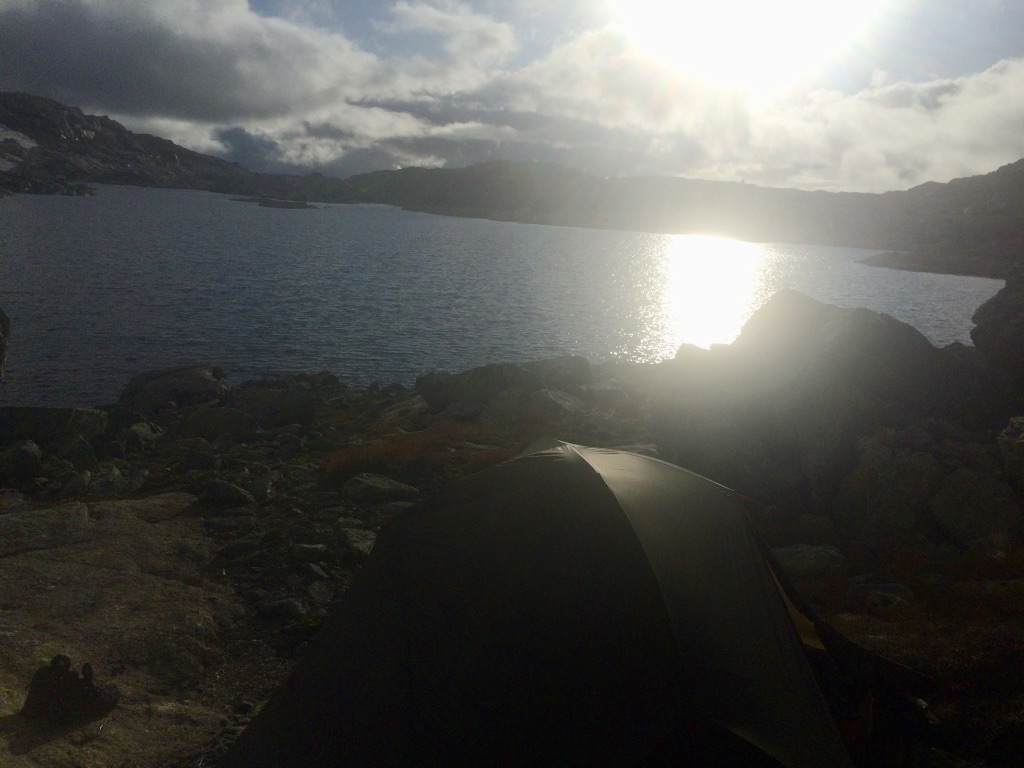
Day 2: Near Gråsidetoppen to Torfinnsheim
The sound of torrential rain beating on my tent woke me up at 5am and it only got worse. This was the bad weather I had been expecting.
I sat sulking in my sleeping bag until around 10, and then dragged myself out: I had to at least cover some ground today.
My tent can be taken down from the inside out, so I was able to pack up all my gear and take down the inner tent without actually going outside. Only when all the things I needed to stay dry (wet == cold == hypothermia later) were packed up did I put on my waterproofs and clamber outside to pack the rain fly and poles.
It was a long, tough day. The rain barely let up and the terrain, tricky in the dry, was lethal when wet. My progress was constantly hampered by river crossings. Nearly all the points the trail led over were now impassible, and several times I had to detour miles up or down stream to find a place where either the river was wide, and therefore slow, enough to wade, or narrow enough to jump.
 One such river at the point I was able to wade across, very far from the trail.
One such river at the point I was able to wade across, very far from the trail.
As I went I continuously clocked potential places to camp, just in case the next river was so flooded that I ended up trapped.
Suddenly, out of the mist loomed this:
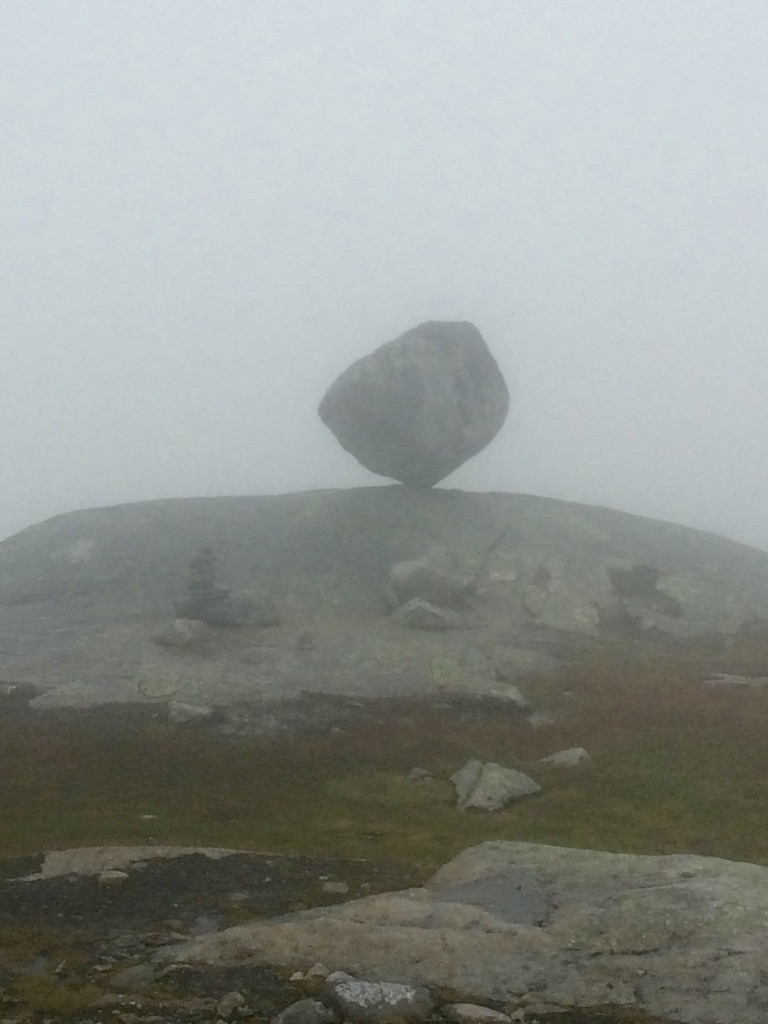
According to my brother, it is called an Erratic. It was about the size of a car, and I can only assume that it has been balancing there since the last ice age glaciers retreated 12,000 years ago. Neat.
As a consequence of the weather, rivers and terrain conspiring against me, I did not make it as far along the route as I would have liked, just 8.6km, but I was rewarded when I came across Torfinnsheim (tor-fin-sshym) cabin. I initially intended to take a quick break on one of the benches outside: it was only around 3pm after all. I also didn’t have the special key members can carry to access the cabin, and assumed that I wouldn’t be able to get inside.
But I tried the door anyway, and found the place open… and completely deserted. Obviously my plan to move on was scrapped the second I spotted the stove with a big pile of wood next to it.
See, as well as thousands of miles of trails, the DNT also maintains around 550 mountain cabins, the majority of which are self-service. They contain store-caches of food, firewood, as well as bunks, a communal kitchen and an outhouse. It is all based on an honour system: visitors simply leave their credit card information, setting out which facilities they used and which supplies they took. There are cleaning tools and materials provided, so everyone can leave the place as they found it for the next guest.
I am sorry that I didn’t think to take a picture, because the cabins really are lovely. I hung everything up to dry near the stove, and had the entire place to myself all night!
Day 3: Torfinnsheim to near Vending
Since I had lost so much time the day before, I was up and out by 9am, ready to really crush some distance.
And, apart from getting lost for 45 mins in some very thick fog, the morning went brilliantly. It was still raining lightly on-and-off, but I was in great spirits bouncing along the trail. Even slipping and falling in a shallow stream did nothing to ruin my enthusiasm. After a little low cloud initially, the skies cleared up, and I was finally able to actually see some of the scenery around me.
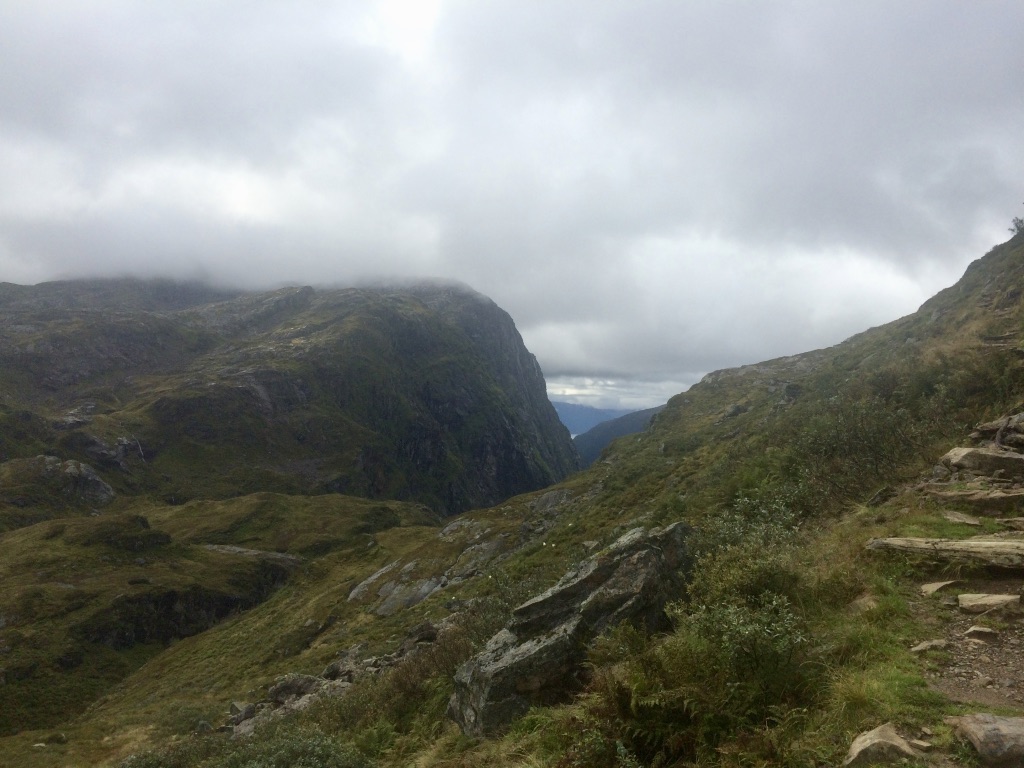
I found myself wishing for more eyes. The trail was fairly fiddly underfoot, and everytime I looked up from where I was putting my feet to gawp at my surroundings, I immediately found myself sitting in a puddle.
This day was the start of a common pattern on my route: losing and then gaining up to 200 metres several times a day, often vertically. It was exhausting, and without my trusty trekking poles I reckon I would have destroyed my knees.
Another common pattern for the next 2 days: Mud.
So. Much. Mud.
Because of all the rain, the ground was completely sodden, which added another layer of “things to pay attention to” when walking.
But not just any mud. There were patches which looked like a regular bit of squelchy dirt, but then when you stepped on them your leg vanished up to your knee. I took to calling these pits “shoe-stealers”, because had I not been wearing gaiters I really feel that my foot would have come back bare.
The afternoon took a slightly annoying turn. At one point the trail comes out over lake Blåkollvatnet, which looks adorable from a height because it is surrounded by all these lovely cabins which have no road access whatsoever. I can only assume the occupants get their supplies by boat from the larger lake Hamlagrøvatnet which lies to the other side of this hamlet, on foot, by helicopter or by snowmobile in the winter. I found out later that these assumptions were correct, and I am completely charmed that people live like that: the dream.
Anyway, coming over the rise to the lake, I could see in the distance (just over a kilometre direct) the trail continuing on the other side. Obviously between me and there was the lake, so I had to walk around it. This meant dropping back down to the treeline and following a very muddy, very rocky, in some places non-existent trail because it was actually in the lake after all the rain. I was also very aware that it was getting on in the day and I could absolutely not get stuck here because there was nowhere at all suitable to camp and even if there was there were so many sheep. Don’t get me wrong, sheep are lovely, but in Norway they all wear bells (presumably for ease of location when they are all allowed to run loose over the mountains) and they are. So. Loud.
At this point I also began to suspect that I had come to a section of trail maintained by a different person than whoever had marked the Voss/Torfinnsheim bit. Where earlier I would have had to really try hard to get lost, now I often found myself standing next to each marker, peering about for a good 5 minutes for the next one. Previously the marks had been up to the size of a car door: impossible not to see. Now they ranged from about an iPhone to a paperback book. At several points I had to make a gut call and head up a vertical slope, getting ready to curse the good people at the DNT if it turned out I had been wrong, only to find the next marker a full 1.5km on from the last.
Unfortunately, whoever did this section also appeared responsible for the rest of my route, and had I not had a (slightly outdated, not fully trustworthy) version of the trail on my Garmin Etrex 30x, I would have lost a lot of time being, well, lost.
Actually that’s not really true: I would have lost time faffing about with a map and compass, the Etrex is just faster. And works in fog.
Finally I began to come out of the treeline again, but I became increasingly concerned that by about 5pm, I had seen nothing but water-saturated marshland for the last 3-4 kilometres. I wasn’t far off Vending cabin, and I didn’t really want to stay there, but the map seemed to indicate the same sort of land in a 5km radius around the hut, and I could see dark, angry clouds coming my way.
Fortunately I managed to find a pretty well drained spot, not too far but nicely hidden from the trail, which didn’t look like it threatened to turn into a bog while I slept.
I called it quits after a very satisfying 16.7km, and got inside just before the heavens opened again.
I realised I hadn’t seen another person since leaving Gjelle on Day 1.
Day 4: Near Vending to Gullhorgabu
I did not sleep at all that night. Not a wink.
Do you remember those sheep and their bells? Well it turns out that I had set up close to a little herd of them, and these buggers appeared to be nocturnal. The bells also seemed to ring at a frequency which my earplugs did nothing to muffle.
Since I was up anyway, I smashed on early and proceeded on my most challenging day of the trip. I’m sure my extreme tiredness contributed a lot (I felt really quite sick), but I can only describe the terrain as ‘fiendish’. In addition to steep height losses and gains which felt vertical, there were sections which genuinely were vertical. In some places one trail marker would appear at the edge of a gorge with the next on its other side, sheer rock faces the only way up or down. Scrambling is the sort of thing I normally find great fun: barely feeling 30% and with a large backpack which completely alters my centre of gravity added an element of ‘interesting’. It was also raining still.
At one point (after I had inadvertently wandered off-trail in a spot where markers were very sparse, again) I had lowered myself down onto a narrow ledge above a 15ft drop, only to immediately realise that out of dumb doziness I had forgotten to factor my backpack into the space. I teetered inexorably on my toes, knowing that I was seconds away from something in my body/the loose slate giving way and the weight of the pack pushing me off. I wedged the fingertips of one hand into a crevice to hold myself in place, while unbuckling my pack with the other and then shifting it off in infinitesimally small shrugs until I was able to let it drop onto the rocks below.
The whole event took less than 10 seconds, and I have been in enough situations where I have needed to save myself that I could keep my cool and barely register the risk beyond what I needed to do to get out of it. After I had climbed down to join my pack, strapped it on and taken a few steps forwards, I turned back to look up at where I had been. It looked even more treacherous at that angle. But I had no time to freak out so I laughed, muttered an “idiot” to myself, and started the mirror climb up the other side of the crevasse.
I think the worst that would have happened would have been a tedious trip-ending injury, but it highlighted an important factor when attempting routes the DNT classes as ‘Black/Expert’ or even ‘Red/Challenging’ (even though I was technically off-trail at that point): physical fitness is not enough, hikers need to be mentally alert at all times. Aside from moments like this, I had come across similar sections on-trail as well as several long sections which were no wider than a gymnast’s balance-beam, littered with slick rocks and mud, with a very long drop below.
Walking in bad weather without sleep on challenging terrain may not have been sensible, is the general lesson of this tale.
Despite all this, I managed to crack out a surprising 14.6 km, which I mainly accomplished by promising myself the reward of spending the night in Gullhorgabu cabin.
I made it there by around 5pm, but this time I was not alone. Gullhorgabu is at the intersection of 4 different trails, and it was a Friday, so we had a full house, including a family with 2 small children under 8 who came tumbling over the rocks in their snow onesies, compasses swinging at their necks.
With the promise of better weather in the morning, I slept very soundly.
Day 5: Gullhorgabu to Lake Herfangsvatnet
The following morning was indeed as forecast, and again I bounded off with infinite energy.
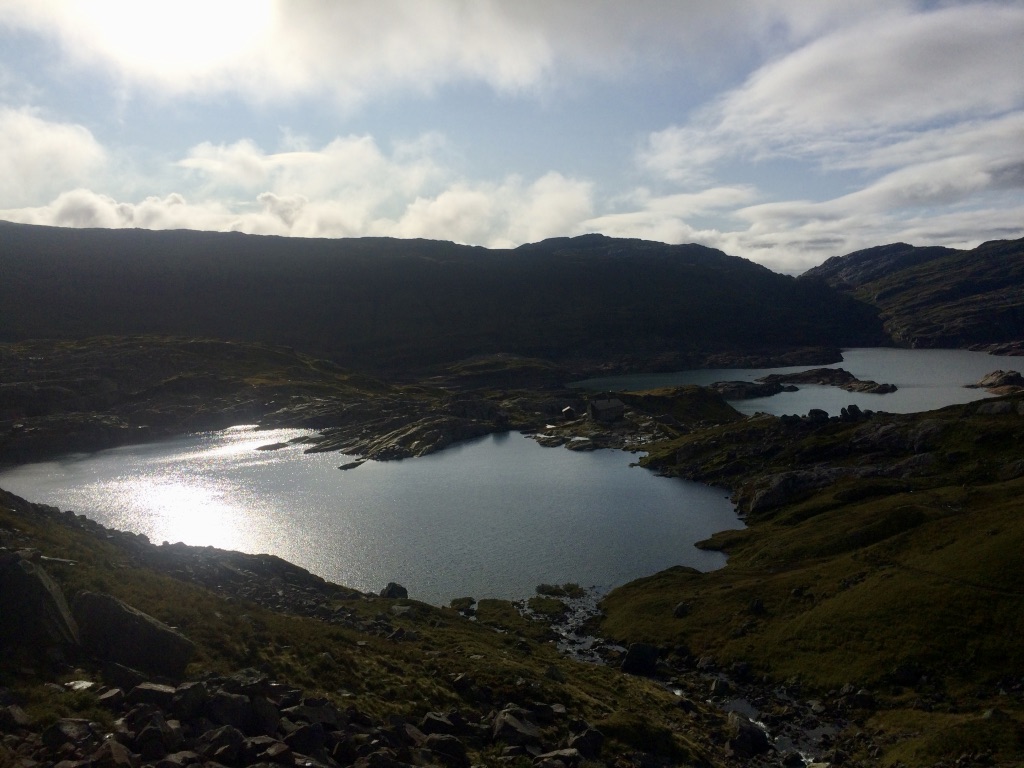 Leaving Gullhorgabu
Leaving Gullhorgabu
Since I had covered so much distance the last couple of days, I only had about 18km to cross over the following 2 and could relax a little.
The section between Gullhorgabu and Høgabu cabin (approx 4-5km) was one of my favourites of the week. It starts with a pretty strenuous climb from 847 to 1100 metres, and the trail then coasts along the top of this stunning plateau.

I was so amazed by everything I could see that, despite some steep clambering over rocks, I was not tired in the least: I could have wandered around up there forever.
Then the mist rolled in. Even though I lost the amazing view, indeed I could barely see 20 feet in front of me and really struggled with trail markers, the experience was indescribable. There was not a breath of wind, and the silence pressed in on me. I had the surreal sense of being underwater; the barren grey rocks under my feet melted into the white mist. It was desolate and haunting and completely electrifying.
When I read ancient Greek myths about the underworld and the banks of the river Styx, this is what I imagine. I almost expected Charon to come slowly rowing towards me.
Eventually as I continued forward the mist began to break up, and the spell was broken. In the gaps between the cloud I saw beautiful patches of sun-drenched grasslands far below slip in and out of sight. At last I was able to see my lunch-time destination in the distance.
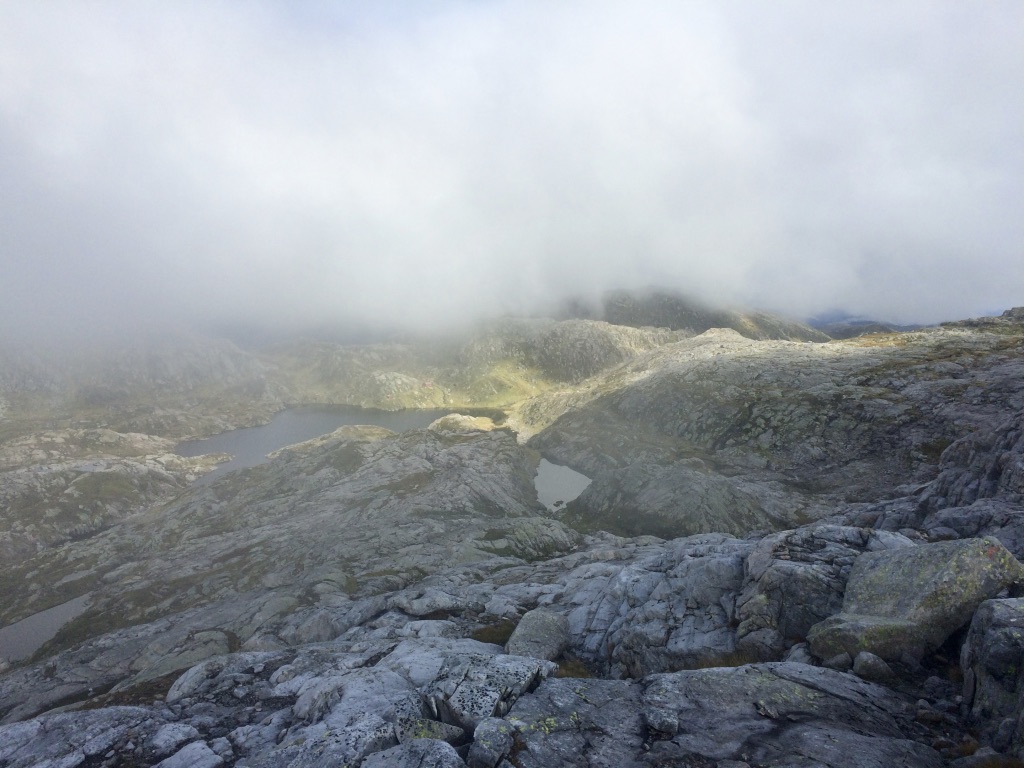
After a nice long lunch in the sun, I turned south-west, honestly thinking it couldn’t get any better than this morning. I was very wrong.
To get to Høgabu I had dropped down to about 890 metres, and after a couple of kilometres following the perimeters of various lakes I began to gain height again. I came out onto a ridge which I believe is called Grønalii, at a height of just under 1000 metres. The view stopped me in my tracks and I started crying. I was completely overwhelmed (probably over-exhausted) and the landscape was unlike anything I had ever seen before. I could see miles in every direction and it felt like being on the roof of the world.
I did take photos, but none of them live up to the real thing so I don’t want to add them here.
I had done about 8km by then and was in such a good mood that I didn’t want to risk ruining it by pushing myself further than necessary. As I descended just over 100 metres to lake Herfangsvatnet I started to scope out potential camping spots and found the perfect one just under 2km further.

I slept exceptionally well and woke up sad that it was my final full day.
Day 6: Lake Herfangsvatnet to Dalestølen
My last full day of hiking started bright and blue and promised to stay that way. I packed up and left by about 9.30, with just under 10km to cover.
The first section was up, up, up. It was so bloody hot. I know I complained about the rain, but I would have killed for at least a cloud at that point. There was no shade at all while following a gorge up from the lake.
There still was barely any wind, and whenever I stopped to take a break, or check my position, the silence and solitude stunned me.
The trail was still challenging (at one point it was simply down the middle of a river, algae-covered rocks included), and the view still staggering.

After a final romp across a boulder field, I began a very muddy and slippery descent. Ahead I could see the landscape changing from endless plateaus to the sharp drops of fjords: I was coming to the end.

I planned to camp my final night at the top of Gamlevarden, which is the last peak (668m) before a sharp descent into Dale. But as I approached I realised something: I could not hear or see any water. I found this very disconcerting, as I had taken the ready availability of water completely for granted until this point: I never worried about it for a second.
The availability of nice camping spots were also few and far between, but one problem at a time.
As I was wandering about looking for anywhere that was not completely waterlogged and/or vertical with also a good supply of running water, I noticed a cluster of cabins nearby and saw a couple of people sitting outside one, watching me roam. I stomped over and asked them if they knew of any water sources nearby. I also spied some nice flat pitches near their cabin, so my next question was going to be if they would mind me setting up so close to them: I had my eye on a cliff-side view.
To my surprise, they immediately called one of their neighbouring cabin owners to see if I could use it for the night.
So I spent my last night with my own little cabin, chatting to my kind new friends, Kurt and AnnBritt. I learned that half of their cabin had wood from the 1700s, and the rest was built in 1926. They told me about the 85 cows which graze up there in the summer, and how the milkmaids who live in these cabins for months at a time send milk down to the valley below with an ingenious system of weighted pulleys.
Kurt and AnnBritt come up to their cabin about 40 nights a year since they retired, even once when it snowed so much they had to dig down from the roof. From their cabin they can see down to their house in Dale, and from their house in Dale they can see up to their cabin.
Naturally I am now desperate to have my own mountain cabin.
Day 7: Dalestølen to Dale
My last day I woke up at the crack of dawn to make my final descent. The route should take approximately 1 to 1 and a half hours, but I wanted to give myself a good amount of time since I knew the going would be tough and I did not want to injure myself doing it in a rush.
The sun was still rising behind the mountains as I left, but it was soon hidden from view as I sank into the treeline.
It was really very, very steep and I could not imagine coming the other way. The trail is all vertical drops over rocks and tree-roots and shoe-stealers and honestly I did most of it on my arse. Here and there chains, ropes and wooden ladders had been laid, but they did little to help. After losing 660 metres of height in under 2km, my knees were very shaky by the end.
At the bottom there was a sign which claimed from Dale to Høgabu was a 7 hour walk which made me giggle; I guess I could imagine doing that without a full pack.
And that was it. I was done, and slowly walked towards the station, not staring at my feet for the first time in days.
Voss felt a very long time ago, and I was sorry that it was all over, vicious head-to-toe bruising and nerve damage in one leg and one arm non-withstanding.
There is really nowhere like Norway for the serious hiker and I am very proud of what I accomplished.
In Bergen airport I ordered myself a massive burger.
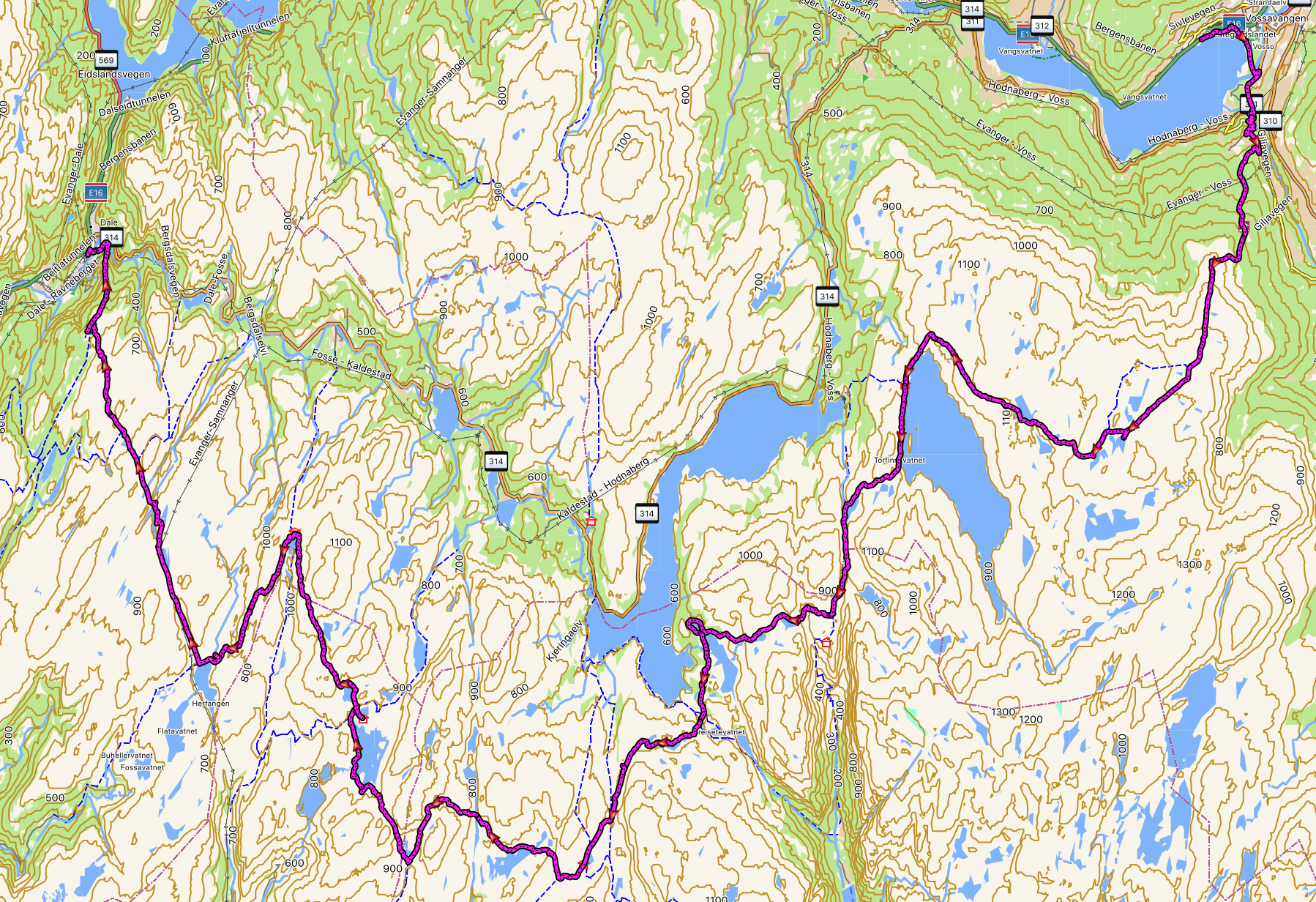
Feeling Inspired? Have some tips!
I cannot recommend Norway highly enough. If you like big views and wild solitude, you really cannot beat it for a multi-day hike. And this is just one tiny section of Norway! There is so much to see! UT.no has loads of great trail ideas so I would suggest that as a good place to start.
Of course the solitude level varies depending on when you go. I purposefully went at the edge of the off-season (first week of September) because I wanted to go days without seeing another soul (check), and because I dislike hiking in warm weather (sort of check). That meant I risked bad weather, but for me that is worth it. The temperature didn’t drop below zero and I was never cold at night.
In the summer (June/July/August) you have the benefit of very long days, which means you are not pressed by swiftly oncoming sunsets to finish up and find somewhere to camp. You can dawdle, take long breaks, relax. It also is still entirely possible that you would have the trails all to yourself even in these months, as they are not part of standard tourist awareness.
There were long stretches where I had no phone service and therefore no connection with my family for days. I have no social media and being off the grid for the week was part of the point, but meandering alone through the mountains can make a loved one worry. For the trip I rented a Garmin InReach Mini satellite tracker and messenger which gave everyone peace of mind. I was initially going to simply get a Personal Locator Beacon so that in case I did something annoying like break my leg, I would be able to press a button and wait for mountain rescue, but in the end I got a device which allowed two-way messaging as well as that. This meant that every evening when I set up camp I could send a pre-baked message with my location to an online MapShare page, where my family could see precisely where I was and know that I was okay. They (and I) also knew that if I were to get seriously injured, I wouldn’t be stuck there hoping someone would happen by me eventually. Sending messages via satellite is quite expensive, so I would only do this once per day, and instructed them to not respond to me. My dad (keen hiker back in the day) especially had fun watching my dots appear across the map and was quite put out on my last night when I got phone service from above Dale and was able to tell them I was alive via WhatsApp.
(Obviously having a device like this requires a measure of common sense since calling a rescue team also potentially puts them in danger. A broken leg or dangerous hypothermia is an emergency. A stomach ache, running out of food or a twisted ankle is not. Basically if you can get yourself off the mountain, or at least to the nearest hut by yourself no matter how slowly, you should not be wasting those resources and risking those lives.)
Another thing I found very exciting about prepping for this trip was the Nordeca map I used. It is a 1:50k topo map of the area I was hiking through and it includes all the DNT maintained hiking trails and huts. But the best features: it is printed on both sides and is made of recycled plastic, so that means it is waterproof! It weighs nothing and you can scrunch it any old way and shove it in your pocket and it will be fine! Hell, I’m sure you could even use it as an emergency hood in heavy rain! If you are not British you may not understand why this is so exciting. The map producer we use for topo hiking maps here is called Ordnance Survey. They print their maps on one side… out of stiff paper which is immensely irritating to fold while indoors let alone on a windy hilltop, and which is decidedly not waterproof… I mean… sigh. If that doesn’t describe a country’s attitude to the great outdoors I don’t know what does.
So is this the trail for you?
If you are brand spanking new to hiking in general (not just hiking and camping) I would say no, not before doing a couple of easier trails first. This route is very, very challenging. The DNT’s difficulty rating system goes from Blue (very easy) to Black (expert), and it is important to note that these are by Norwegian standards: these people start hiking at 5 years old and are tougher than rock eating glaciers. Every section of the trail I was on was marked Black or Red (challenging) and required high levels of fitness and mental awareness.
If you are already a hiker, you know the sort of training necessary to complete something like this. I would still suggest increasing your regular routine, because honestly you cannot be fit enough.
There is of course the option to not camp at all, and then the whole situation becomes somewhat easier (still a lot of work for newbies). Some of the cabins scattered at regular intervals have pre-bookable bunks… but you have to be there by 7pm so this means really cracking on with the longer stretches. However, there is usually always room, so it is not the end of the world if you get there late, but you have to get there.
The benefit of hut-to-hut hiking is of course not needing to carry all that extra weight (just a sleeping bag liner and some layers), not having to learn camping skills, and not having to tolerate constantly wet boots.
The benefit of camping is that you can drop wherever you want, whenever you want. And thanks to Norway’s principle of allemannsretten, the thousand year old right to roam, there is no need to worry about trespassing, so long as you follow the basic rules of camping etiquette and Leave No Trace.
To see what I took with me, check out my gearlist. If you have any questions about Norway or hiking in general, please don’t hesitate to reach out, email at the bottom.
